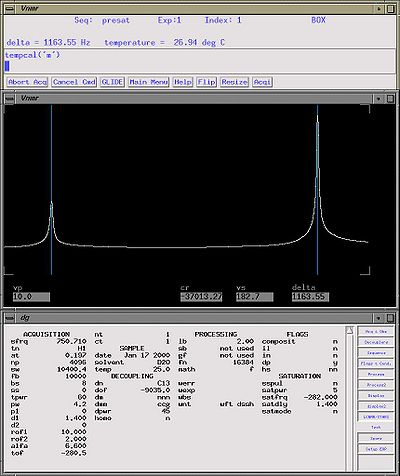Temperature calibration
Temperature control is crucial for NMR experiments. There remains always a small discrepancy between the actual temperature of the sample and the temperature displayed in the monitor. The true sample temperature may depend on the airflow speed and the temperature of the air supply. In particular, discrepancies may be different for different spectrometers. We use temperature calibration from time to time and keep a record in order to calibrate the temperature accurately. The samples used for temperature calibration are methanol (for low temperature range) and ethylene glycol (for high temperature range).
IMPORTANT! In a recent MRC paper it has been reported that radiation damping can significantly affect the accuracy of temperature calibration. Spectrometers equipped with cryogenic probes are affected the most. Systematic errors of up to 2-3 °C were observed. As a solution, the authors recommend to observe residual proton signals in a sample of highly deuterated methanol (typically 99.8% methanol-d4). At present (Sep 2007), NYSBC employs this method for calibration of its spectrometers. Thomas Szyperski's lab is also adopting this protocol.
Temperature dependence of 1H HDO chemical shift in D2O
The general formula is
δ = 5.060 - 0.0122*T + (2.11 * 10^-5)T^2
In the range 0-50 °C it can be linearized to
δ = 5.051 - 0.0111*T
Here δ is the chemical shift relative to TMS, and T is the temperature in °C
For the reference see http://pubs.acs.org/doi/abs/10.1021/jo971176v
Using highly deuterated methanol
Highly deuterated methanol is not yet provided as a standard sample, but you can order it from any supplier of isotope-labeled chemicals.
Consult you spectrometer's manual on how to prepare a sample. For Varian, a sample of not more that 3 cm in height in a regular tube is sufficient. You may want to avoid using very low sample height as it would affect the shimming.
You can tune/match the proton channel and lock the sample to the methanol signal. Because methanol spectrum has two lines, methyl and hydroxyl, the lock line will have a small modulation.
Gradient shimming on deuterium can always be used. It is possible to use gradient shimming on protons on spectrometers equipped with cryogenic probes. In this case you need to increase the gain and use a longer excitation pulse.
Because the sample is randomly deuterated to high degree, the hydroxyl signal mainly comes from the CD3OH species, while the methyl signal comes from CHD2OD. The methyl signal thus appears a 1:2:3:2:1 quintet due to 2J_HD scalar coupling of about 2 Hz. The chemical shifts of these two groups differ from those of pure CH3OH because of deuterium isotope effects. Therefore, macros for temperature calibration based on pure CH3OH (e.g. tempcal('m')) SHOULD NOT be used. The authors provide their own calibration function:
T = -16.7467 * (Δδ)^2 - 52.5130 * (Δδ) + 419.1381
where Δδ is the chemical shift difference between the two lines.
A macro tempcal_cd3od has been created to perform temperature calculation according to the above formula.
Since the lines are much more narrow than in pure CH3OH, simply placing the left and right cursors on the peaks is not accurate enough. A better procedure is the following:
- Zoom in on the -OH peak and position the left cursor exactly on the peak maximum.
- Type r1=cr to save the current cursor position.
- Zoom in on the CH3 peak and position the left cursor exactly on the peak maximum.
- Type r2=cr to save the current cursor position.
- Zoom out.
- type delta=r1-r2 to calculate the frequency difference in Hz. This will also set the spacing between the left and right cursors.
- type tempcal_cd3od to launch the macro.
Using standard samples
To verify the temperature do the following:
- Put the standard sample in the magnet and equilibrate it at the desired temperature.
- Record a basic 1D spectrum (use presat, s2pul, or water experiments).
- Select Box in the menu and set the cursors on 2 large peaks (one hydroxyl and one aliphatic)
- Key in tempcal('m') or tempcal('e') for methanol or ethylene glycol, respectively.
Important points to consider:
- The standard samples normally contain small volumes of pure methanol or ethylene glycol. There is no lock substance, so 1D is run without lock.
- Lineshapes will be poor, but shimming is not necessary either. Both peaks will have the same shape and it is the frequency difference between them that matters.
- Probe tuning and matching should be skipped. A detuned probe will diminish radiation damping. Use very small tip angle (for example, pw = 1) to avoid ADC overflow.
- When using experiments such as presat and water, turn presaturation off (satmode='n'), otherwise the hydroxyl signal may be distorted.
- The following keywords are acceptable arguments of tempcal: 'methanol' or 'm'; 'glycol', or 'e', or 'g'.
